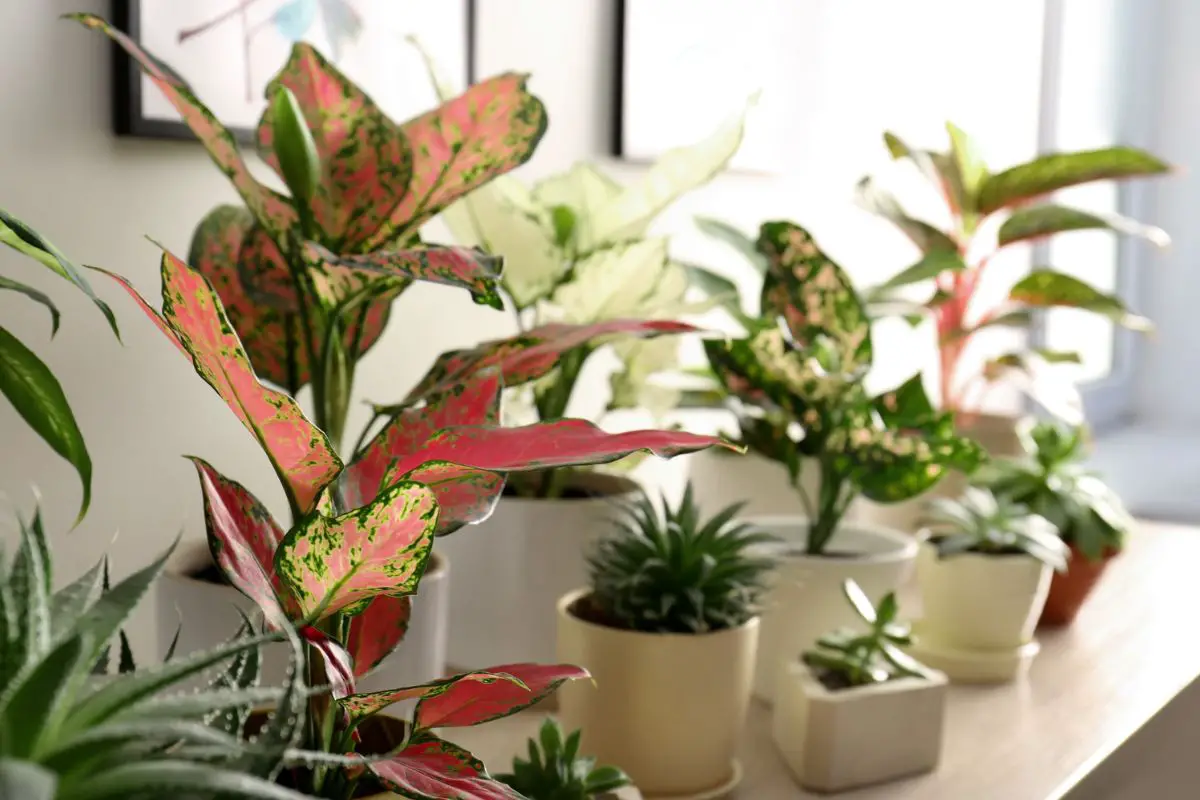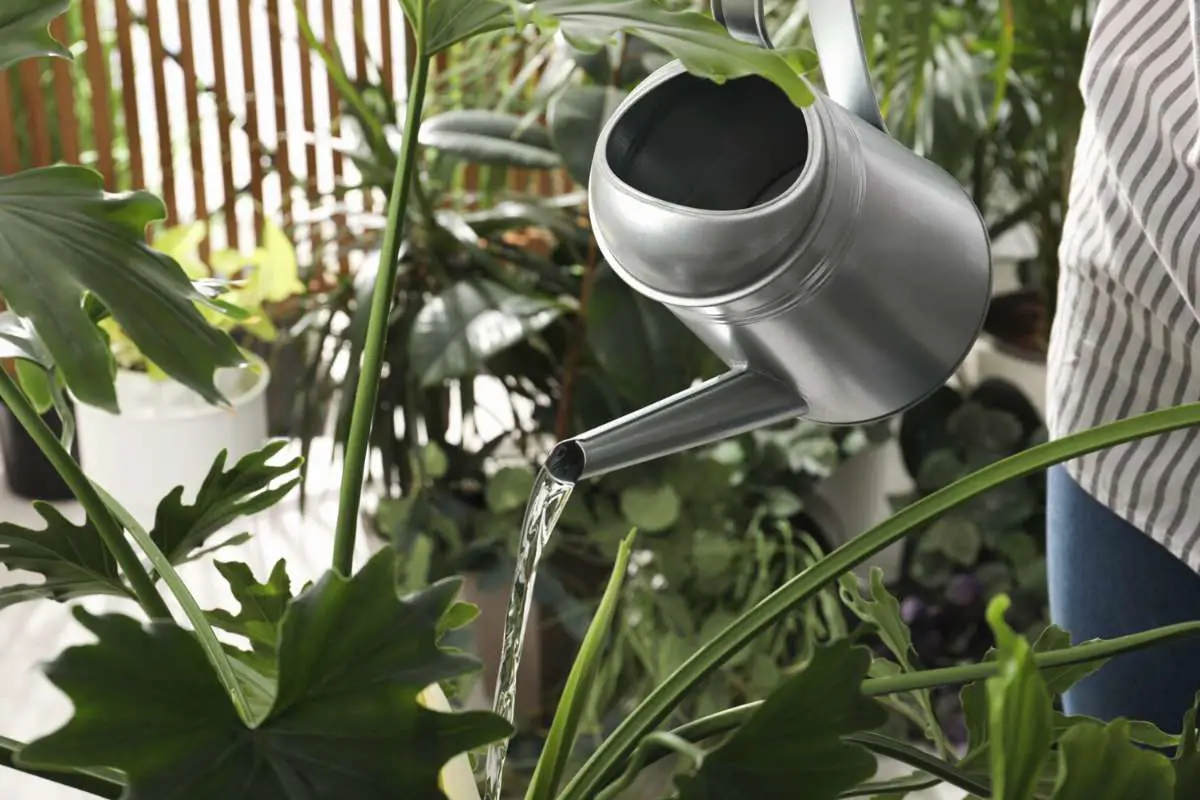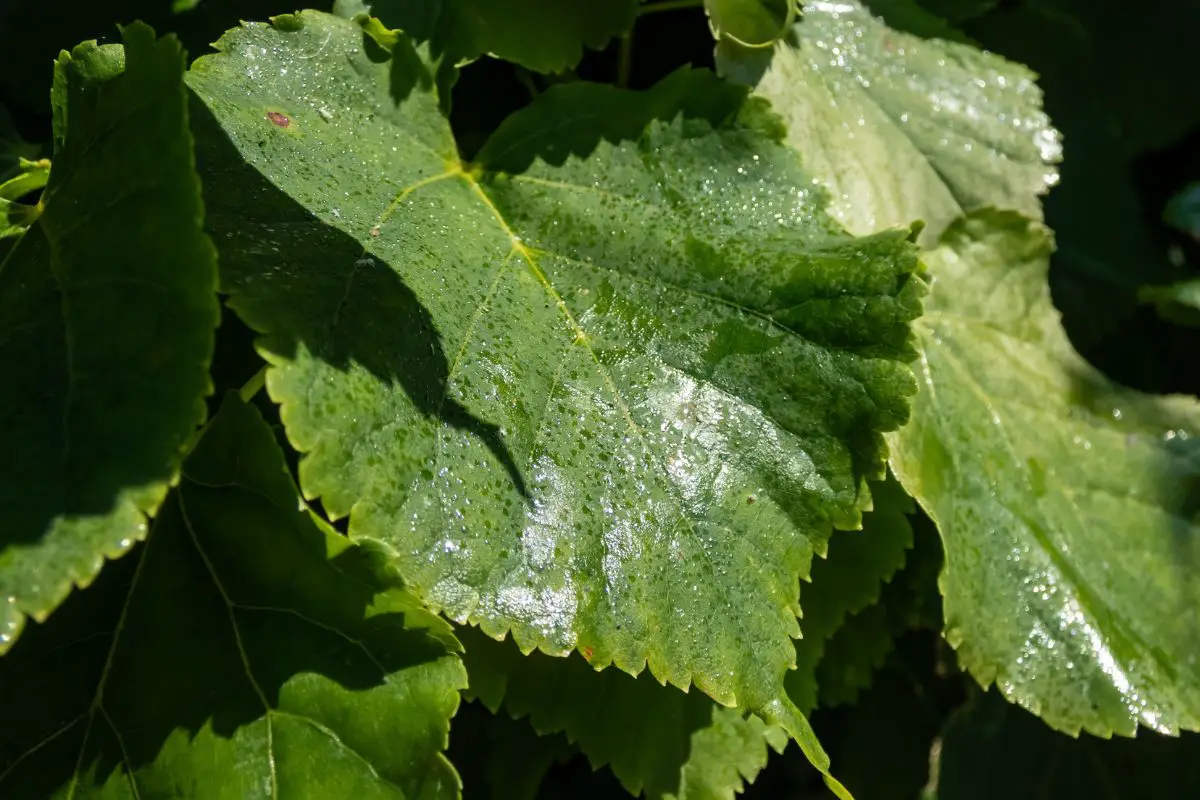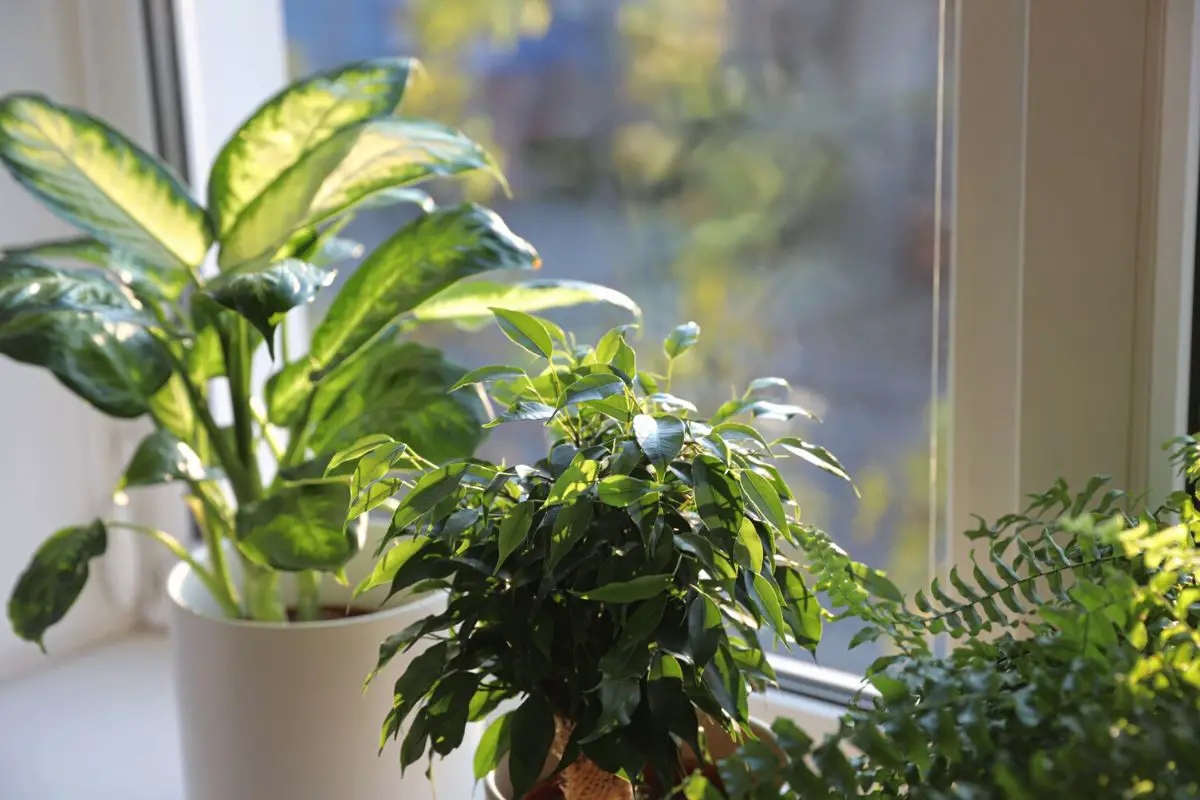String of pearls is a unique houseplant because of its fleshy foliage that looks more like beads than leaves. This plant produces small, fragrant white flowers when kept in suitable conditions indoors. One downside of growing this plant is that it can sometimes feel sticky.
The string of pearls can sometimes feel sticky because of its sap leaking naturally. The stickiness may also be due to poor light and watering conditions or the honeydew produced by insect pests like aphids, mealybugs, and whiteflies.
This article will discuss the reasons behind this phenomenon in more detail and provide practical solutions. I will also share some care tips to reduce the stickiness due to natural causes and prevent those caused by pests or poor growing conditions. Read on to learn more!

A Quick Overview
The string of pearls (Senecio rowleyanus or Curio rowleyanus) is a succulent and is a member of the daisy family Asteraceae. The plant sprawls in the ground in its native environment and remains protected from intense sunlight by the nearby rocks and shrubs.
As a succulent and native to the dry areas of South Africa, this plant stores moisture in numerous plump, globular leaves attached to long, fleshy stems. The unusual shape of the leaves also reduces moisture loss through transpiration and evaporation.
Each leaf is about a quarter of an inch (6.3 mm) in diameter with a short pointed tip. It can be as green as peas or jade with a singular translucent band of darker green, which allows light to pass through and facilitate photosynthesis.
The stems can reach about 3 feet (0.9 m) long and usually grow shallow roots in spots where they touch the soil. This behavior allows the plant to seek more moisture and anchor itself into the ground.
These unique leaf and stem features give the plant drought tolerance.
In summary, the string of pearls plant thrives in the following conditions in their natural habitat:
- Bright, filtered light
- Dry to moderately humid environment
- Mild rains 3-9 days a month, averaging 1-2 inches (2.5-5 cm) a month in winter and 3.5-6 inches (9-15 cm) in the summer
- Warm summer temperatures around 65-80 °F (18-27 °C) and non-freezing winter temperatures of 45-60 °F (7-15.6 °C)
In the US, the string of pearls plant is a popular indoor ornamental often grown in hanging baskets or pots on high shelves. The lack of soil space causes the plant’s unique stem and foliage to trail like beaded curtains from a planter.
It does well in a warm and moderately dry spot indoors (30-40% humidity) with bright, indirect light and infrequent watering similar to its native environment.
Although the care requirements of the string of pearls plant look simple enough, you will notice your plant becoming unhappy when it becomes too sticky.

Symptom of Stickiness
The stickiness due to natural causes in a string of pearls plant is generally odorless and colorless. Sometimes, it can even go unnoticed unless you touch the leaves.
In some cases, you will notice the following symptoms that may appear along with the stickiness:
- Black sooty mold
- Rotting smell
- Visible water droplets
- Discoloration of the stem and leaves
These additional symptoms will help you determine the reason for the stickiness, which I will discuss further in the next section.
Common Reasons and Treatments
There are a few reasons your string of pearls plant can become sticky. Some of them don’t warrant treatment, while others require immediate attention. It’s crucial to identify the reason accurately to determine if it requires human intervention.
Natural Causes
As discussed, the string of pearls plant is native to the arid regions of South Africa where there are only 3-9 days of rainfall each month. The amount of rain is also quite low at around 3.5 inches (9 cm) per month.
As it rains, the plant needs to soak up as much moisture as it can to thrive during dry days. However, there’s a limit to how much water the plant can store in its leaves, so the excess comes out in a process called guttation.
Guttation is a defense mechanism in plants where they release moisture through their leaves in clear liquid form instead of vapor at times when the root pressure is high, but the evaporation rate is low.
As a houseplant, a string of pearls generally grows in a moderately lit area with controlled temperatures. Every time you water your plant, it will try to absorb moisture and store it in the leaves. The high root pressure will trigger the guttation response.
Guttation is safe as long as the bead-like foliage remains firm, plump, and green. If your plant is sticky but looks healthy without visible pests, then the stickiness is due to a perfectly normal response to watering.
In this case, you don’t need to treat your plant other than occasionally wiping the bead-like leaves with a moist, clean cloth to prevent dust accumulation, which can inhibit photosynthesis and transpiration.
Pest Infestation
Due to its succulent stems and leaves, the string of pearls plant is attractive to common houseplant pests like aphids, mealybugs, and whiteflies. These pests come into your home through plants or potting soil infested with eggs and larvae.
Once these eggs and larvae mature, they suck the sap out of the leaves and stems and excrete honeydew. Honeydew is a colorless, odorless, sugary, sticky substance, which is a by-product of the pests’ digestion of the sugars in the plant sap.

This substance invites other insects like ants, ladybugs, and lacewings. Although ladybugs and lacewings are beneficial insects whose larvae and adult forms feed on aphids and mealybugs, they’re unlikely to come inside the household.
The lack of natural predators increases pest populations for your indoor plants.
Honeydew produced by insect pests also attract sooty mold fungi. Although this black mold doesn’t harm your plant directly, its presence on the leaf surface can obstruct sunlight and prevent photosynthesis.
Due to the odd shape of the string of pearls’ leaves, the translucent band is the only area light can pass through. If this epidermal window is obstructed by sooty mold, it can cause discoloration in the affected foliage.
A few pests feeding on your plant and sooty mold here and there don’t pose a serious threat to your plant. However, severe infestations can eventually kill your string of pearls, especially if your plant is stressed.
To treat the issue, you may use the following methods:
Cotton Swab With Alcohol
Manually removing visible pests is the first step to dealing with the infestation. You can use a cotton swab moistened with 70% isopropyl alcohol to dislodge the pests and drop them into a cup of soapy water.
Focus on the areas between the leaves and stems where the pests may hide.
Neem Oil Spray
Neem oil spray is one of my favorite organic solutions because it works against most plant pests and fungi. Just mix a tablespoon of pure neem oil with one tablespoon of liquid dish soap and 0.26 gallons (1 liter) of water.
Test-spray the solution on one healthy leaf and wait 24 hours for any adverse reaction. If you see discoloration (yellowing) on the leaf, dilute the solution by adding another 0.26 gallons (1 liter) of water and mix well. Otherwise, it’s safe to use the initial concentration.
Spray the neem oil solution all over your plant once a week until you don’t see pests anymore. Continue spraying the solution every 2 weeks to prevent reinfestation.
Do this before sunrise and ensure your plant is not in direct sunlight during treatment. Unlike other plants that require nighttime applications of neem oil, succulents like the string of pearls open their stomata at night.
Overwatering and Excess Soil Moisture
Proper watering is one of the care requirements of a string of pearls plant that is hard to get right in an instant. This plant doesn’t like too much water but can quickly shrivel with insufficient water.
Habitual overwatering and poor soil drainage can cause root rot in any plant. Wet soil can encourage harmful fungi to proliferate and feed on your plant’s roots.
Although your string of pearls can become sticky from regular watering, the stickiness from overwatering or excessive soil moisture can present several other symptoms.
The string of pearls plant has fragile roots that can rot quickly when constantly wet. The roots will turn black and smell of rot or decay. The leaves will also become wrinkly and mushy in addition to feeling sticky.
In case of root rot, it’s best to propagate healthy foliage instead of treating the entire plant. Here’s how:
- Cut 3-5 inches (7.6-12.7 cm) of healthy stems far from the rotten portions. Use sterile pruning shears to prevent the spread of pathogens.
- Prepare a fresh and sterile potting mix. You can use a pre-made cactus potting mix or make your own by mixing equal parts potting soil, pumice, and perlite.
- Fill a sterile pot with the moistened potting mix, leaving an inch (2.5 cm) of space between the mouth of the pot and the soil surface. I prefer to use a 6-inch (15 cm) pot with drainage holes for my string of pearl cuttings. Choose a shallow terracotta pot for better aeration and drainage because this plant has shallow roots.
- Lay the cuttings over the soil surface and cover 3-5 nodes with ⅛-¼ inches (3.2-6.4 mm) of soil. The roots will grow from these nodes.
- Place the pot in an area with bright, indirect light, such as a shelf about 5 feet (1.5 m) away from a bright eastern or southern window.
- Water the soil enough to keep the top inch (2.5 cm) moist as the plant develops roots within 2-4 weeks.
Intense Sunlight and Temperatures
Too much heat and sunlight can cause sun stress in your string of pearls. A stressed plant will have pink or purple leaves. Prolonged exposure to intense sunlight will cause the leaves to shrivel and sometimes secrete sap, leading to stickiness.
Moving your plant to a shadier spot or hanging a sheer curtain over the nearby window for 1-2 weeks will help your plant recover. You can prune the discolored parts if they’re wilting to avoid wasting the plant’s energy trying to save them.
Although the discolored parts won’t regain their original color, the rest of the plant will survive. Gradually move the plant back into brighter but indirect light and rotate the pot by 90-180° weekly.
You can grow a string of pearls outdoors if you live in a frost-free area or during the warm season if you live in USDA zones 9-11. Place the plant in an area that receives partial shade from the intense midday and afternoon sun.
Move your plant to a cool and shady spot when temperatures are expected to rise above 80 °F (27 °C). Also, ensure that you move the plant back indoors before the nighttime temperatures fall below 45 °F (7 °C).
Diagnosing the Problem
Before addressing the issue of stickiness, it’s crucial first to understand whether it’s the plant’s normal response or a consequence of poor plant care.
Here are some ways to diagnose the issue:
Visual Inspection
Check the plant for other symptoms that can indicate a problem.
For instance, if the sticky spots turn black, this can indicate the presence of sooty mold and confirm that the liquid is honeydew. This is further confirmation that pests have visited your plant.
Look for pests based on the following traits:
- Aphids can be brown, orange, or green.
- Mealybugs are crawlers with a cottony white waxy covering.
- Whiteflies adults also have cottony white covering while the larvae or nymphs are white or translucent.
Even if there are no visible pests, you can try to inspect the neighboring houseplants. Pests can jump from one plant to another, especially if they’re grouped too closely together.
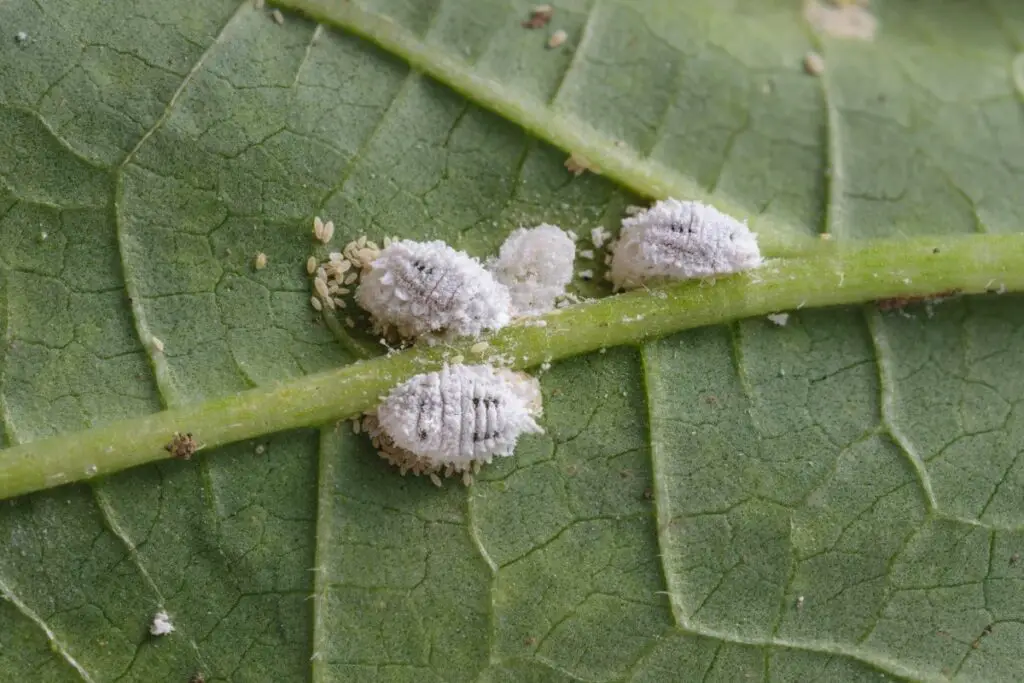
Environmental Assessment
If there are no pests or sooty mold, check the soil for moisture. An appropriate potting mix for a string of pearls should be partially dry 3-5 days after watering. Wet soil can indicate overwatering or poor drainage.
Evaluate the plant’s current position. You’ll know if the plant’s getting too much sunlight if the leaves and stems turn pink or purple. On the other hand, insufficient light will make your plant appear limp and paler.
Prevention Tips
A solid plant care routine is necessary to ensure your string of pearls remains in the best shape.
Below are some tips to help make it easier for you and your plant:
Regular Inspection and Maintenance
Regular inspection and proper maintenance can prevent issues from getting out of control. For instance, a weekly inspection for signs of pests and eliminating them on sight will ensure that minor attacks won’t blow up as a major infestation.
On the other hand, cleaning your plant once every 1-2 weeks with a moist and clean cloth to remove dirt and moisture (from honeydew or guttation) will ensure that your plant can photosynthesize and transpire properly.
Optimal Growing Conditions
Finding the sweet spot for your string of pearls plant requires trial and error at first, but once you find a suitable place for your plant, keep the following care tips in mind:
- Soil quality: The soil should be well-draining and has a pH of 6.5-7.0. A potting mix with equal parts potting soil, pumice, and perlite is perfect for a string of pearls.
- Water: Water your plant only when the top half of the potting mix is dry. Don’t let the soil remain too wet or become bone dry between watering sessions.
- Light: Your string of pearls will do well with 4 hours of morning light from an eastern window or a full day of bright, indirect light from a curtained southern window.
- Temperature: When growing the plant indoors, it’s best to maintain stable summer temperatures between 70-80 °F (21 and 27 °C) and winter temperatures of 50-60 °F (10-15.6 °C).
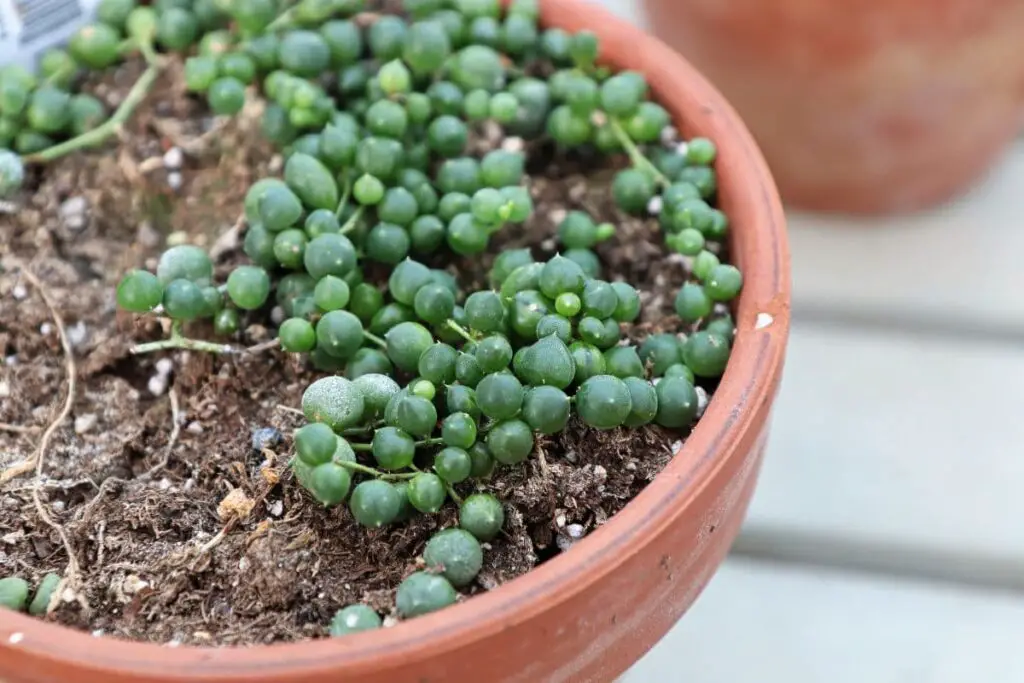
Proactive Pest and Disease Control
More importantly than dealing with pests, you can avoid pests and diseases from affecting your plant in the first place by being proactive with your preventative measures.
Spraying a neem oil solution on your plant once every 2-3 weeks should be enough to keep pests and fungi at bay. You can also use the neem oil solution to wipe the surface of the leaves to remove dust.
Remember to do this before sunrise and to keep your plant away from direct sunlight. It’s crucial to avoid exposing the oil to sunlight and leaving burn marks on the succulent leaves.
Fertilizing and Propagating
The string of pearls plant can grow quickly, adding around 5-10 inches (12.7-25 cm) of growth annually until it reaches the maximum of 2-3 feet (60-90 cm) indoors. To support its quick growth, the plant needs regular fertilization during the growing season.
Apply half-strength 10-10-10 liquid fertilizer every 2 weeks from spring to mid-summer. Increase the interval to every 4 weeks in late summer to prepare the plant for less activity in the fall. Stop fertilizing after the first fall frost, even for indoor plants.
The plant has shallow roots and typically won’t need repotting for 3-4 years. However, it can lose vigor after a few years, so it’s best to propagate the cuttings after 5 years in a fresh potting mix.
Instead of repotting an old plant, I prefer doing succession planting by regularly removing a healthy 3-5-inch (7.6-12.7 cm) stem cutting and planting it in fresh soil. This way, I can have a few young and vibrant string of pearls plants to replace the spent and fading ones.
Final Thoughts
The stickiness in a string of pearls plant can be a normal plant reaction called guttation. The plant normally absorbs much water during the rare occasions it receives rain or watering and releases the excess through the pores in the leaves.
However, stickiness due to overwatering, intense sunlight, and pest infestation needs immediate attention to save your plant. Watch out for other signs that accompany the stickiness, such as sooty mold, discolored or wrinkly leaves, and smelly roots.
Timely diagnosis and treatment can help save your plant. In severe cases, you may find some healthy sections along the stems and propagate the plant through cuttings.

